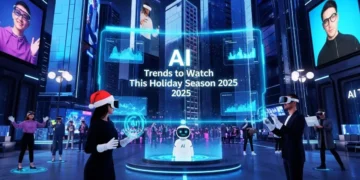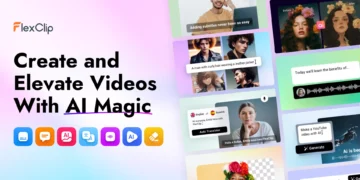The festive season is upon us, and with it comes the familiar whirlwind of gift hunts, travel planning, and decking the halls. Yet, something is fundamentally different this year. Artificial Intelligence has moved from the realm of tech showcases to the center of the holiday experience, acting as a personal concierge for shoppers and a strategic powerhouse for retailers.
Feeling overwhelmed by endless product choices and worried about finding the perfect gift? You’re not alone. In 2025, AI is transforming holiday shopping from a stressful chore into a curated, efficient, and even joyful journey. Nearly all large U.S. retailers (97%) are now using AI to enhance your experience, and a significant 40% of consumers plan to leverage it for their own shopping needs .
This article is your essential guide to the top AI trends this holiday season. We’ll explore how this technology is not just changing what we buy, but how we buy, plan, and celebrate. Ready to see how AI can save you time and money while making this season merrier? Let’s dive in.
Why AI Trends Are Dominating the 2025 Holiday Season
The adoption of AI tools for holiday shopping is skyrocketing. Recent studies show that nearly two-thirds of consumers are planning to use AI-powered deal discovery and personalized product recommendations to find gifts and savings this year. Retail giants like Walmart and Amazon are integrating AI chatbots and generative AI features to offer transparent, conversational guidance throughout the shopping journey. For example, Walmart’s partnership with OpenAI allows customers to shop directly through ChatGPT, while Amazon’s “Help Me Decide” feature uses browsing and purchase history to deliver tailored recommendations.
But it’s not just about shopping. AI traffic to retail sites is expected to surge by over 520% compared to last year, with most of this growth coming from Large Language Models (LLMs) and AI-powered search assistants. This means your content needs to be optimized not just for Google, but also for AI-driven search engines and voice assistants.
The State of Play: AI Goes Mainstream
The numbers speak for themselves: AI has officially gone mainstream in the consumer landscape. What was once a futuristic concept is now a practical tool embedded in the apps and websites you use every day. The question has shifted from “Will you use AI?” to “How will AI enhance your holiday?“
Adoption has skyrocketed on both sides of the transaction. A compelling study from Deloitte reveals that 33% of all U.S. consumers plan to use AI for their holiday shopping, with that figure jumping to 43% among Gen Z . This isn’t just passive acceptance; it’s active engagement. Consumers are reporting that AI reduces holiday stress, with 69% feeling it makes them happier and 70% feeling less anxious during the shopping process .
On the retail front, the integration is even more profound. Leaders across the industry are scaling AI applications at a remarkable pace. According to industry data, 85% of retailers now use predictive analytics, 83% use AI agents for shopping assistance, and 79% leverage AI for customer service, representing a massive year-over-year increase . This isn’t experimentation—it’s full-scale deployment for the most critical shopping period of the year.
Top AI Trends Transforming the 2025 Holiday Season
1. The Rise of the AI Shopping Assistant
Forget endlessly scrolling through online stores. This season, AI-powered shopping assistants are becoming the ultimate digital sidekick for consumers. These sophisticated tools, often in the form of chatbots or integrated agents, are designed to handle the heavy lifting of holiday preparation.
So, how exactly are shoppers using these assistants?
Personalized Gift Ideas: Struggling to find a gift for your hard-to-please nephew? AI for gift recommendations is a game-changer. By analyzing patterns and preferences you provide, these tools can suggest thoughtful, tailored options. In fact, 67% of consumers plan to use AI for this exact purpose, up significantly from 54% just last year . As one expert notes, “You can use AI to reason about the preferences and likes of loved ones based on what you know about them” .
Mastering Your Holiday Budget: With AI finding the best deals, three out of four consumers (75%) are leveraging technology to stretch their budgets . These assistants can compare prices across retailers, summarize lengthy product reviews in seconds, and alert you to promotions, ensuring you get the most value for every dollar spent.
Major retailers are all-in on this trend. Pandora, for instance, has introduced ‘Gemma,’ a shopper-facing agent built to help customers discover their iconic jewelry pieces . Similarly, American Eagle launched an AI gift guide on WhatsApp, providing personalized suggestions at scale .
2. Hyper-Personalization: The End of One-Size-Fits-All Gifting
The era of generic marketing is over. In 2025, AI-driven personalization is creating uniquely tailored shopping experiences that feel like they were designed just for you. This trend goes far beyond simply inserting your name in an email.
AI and personalized shopping experiences are now capable of leveraging your past browsing behavior, purchase history, and even real-time intent to serve up incredibly relevant product recommendations. This is a powerful antidote to the dreaded “decision fatigue” that plagues shoppers facing infinite online choices .
The impact is tangible for retailers who get it right. Those using AI for personalized pricing and promotions report higher holiday sales, a stronger competitive edge, and improved customer loyalty . For you, the shopper, it means less time wading through irrelevant products and more time discovering gifts that will truly delight your loved ones.
3. Smarter Supply Chains and Fulfillment
While less visible to the consumer, one of the most critical AI trends in holiday logistics is happening behind the scenes. AI in inventory management is helping retailers ensure that the hot toy of the season is actually in stock and can be delivered in time for the holidays.
FedEx, for example, is leveraging AI-powered visibility tools like SenseAware, which gives merchants real-time visibility across their entire supply chain . This allows for smarter inventory placement and more reliable delivery estimates. In a season where shipping costs and reliability are a top concern for 82% of consumers , these AI-optimized logistics are not just a nice-to-have—they are essential for meeting customer expectations.
4. The New Discovery Channel: AI as Your Search Engine
Move over, Google. A seismic shift is occurring in how consumers begin their shopping journeys. Generative AI in retail is emerging as a primary starting point for product discovery. Platforms like ChatGPT and Perplexity are seeing astronomical growth in retail-related traffic.
The data is staggering: during Amazon Prime Day in July 2025, traffic to retailer websites from generative AI platforms surged 4,700% year-over-year . Furthermore, Adobe forecasts that during the holiday season, traffic from AI sources to retail sites will rise by 515-520% compared to 2024 . This proves that more and more shoppers are starting their quest with an AI advisor, not a traditional search engine or storefront.
This trend is a game-changer for product discovery. Instead of typing fragmented keywords, you can have a conversational query: “What are thoughtful housewarming gifts for under $50 for a new homeowner who loves gardening?” The AI can understand the context and nuance, returning a curated list of ideas and retailers.
5. Building Trust in the Age of AI
As AI becomes more embedded in our lives, a new consumer demand is emerging: transparency. This year, the conversation is evolving from what AI can do to how it should be used. Building trust with AI is the new competitive frontier.
Shoppers are welcoming AI, but they also want clarity. A significant 84% of consumers want to know when AI is being used, and 60% are calling for stricter oversight and standards . This creates a “trust contract” between brands and their customers. Retailers who are open about their use of AI—explaining how it powers recommendations, price alerts, or delivery updates—will build deeper loyalty. As the data suggests, when customers understand how AI is helping them, they feel seen rather than surveilled .
6. AI-Powered Deal Discovery
Consumers are increasingly using AI tools to find the best deals and discounts. These tools can track prices in real time, compare offers across retailers, and send personalized alerts. To leverage this trend, consider integrating AI-powered deal discovery features on your site or partnering with platforms that offer these services.
7. Personalized Product Recommendations
AI is revolutionizing how products are recommended. By analyzing browsing history, purchase data, and demographic information, AI can deliver highly relevant suggestions that boost conversion rates. Retailers are using this technology to create tailored shopping experiences that keep customers engaged and coming back.
8. Conversational Commerce
Chatbots and voice assistants are becoming integral to the shopping journey. Walmart’s integration with OpenAI and Amazon’s “Help Me Decide” feature are prime examples of how conversational AI is making shopping more seamless and personalized. Businesses that adopt these technologies can provide instant support and guidance, improving customer satisfaction and loyalty.
9. Real-Time Data and Identity Resolution
Retailers are using AI to analyze real-time data and resolve customer identities across multiple touchpoints. This allows for more accurate targeting and personalization, driving higher conversions and long-term customer relationships.
Actionable Tips: Leveraging AI for Your Best Holiday Ever
How can you, as a consumer, practically harness these AI trends this holiday season? Here’s a quick guide:
Start with an AI Concierge: Before heading to a store website, try asking a tool like ChatGPT or Google’s Gemini for gift ideas based on a person’s hobbies and age. You might discover creative options you hadn’t considered.
Embrace AI for Price Comparison: Use AI shopping tools to find the best deals. Simply ask, “Find me the best price for [product name] across major retailers.” Many browser extensions now offer this functionality automatically.
Let AI Handle the Logistics: Use AI for travel planning your holiday trips. AI can generate personalized itineraries in seconds, from restaurant suggestions to transit options . FedEx’s AI-powered tools like Delivery Manager also allow you to schedule deliveries or redirect packages, adding flexibility to your holiday shipping .
Look for Transparent Brands: Support retailers who are clear about their use of AI. This not only rewards ethical practices but often leads to a better, more intuitive shopping experience.
The Future Beyond 2026
The impact of AI on holiday shopping is still in its early chapters. The trends we see today—hyper-personalization, AI-driven discovery, and intelligent logistics—will only deepen. We can expect a future where AI doesn’t just recommend a product but helps you visualize it in your home via AR, or automatically manages your gift budget across all retailers.
The integration of AI will become so seamless that it will feel less like using a tool and more like having a helpful partner throughout your holiday preparations. The retailers who will thrive are those who view AI not as a cost-saving automation tool, but as a means to foster genuine human connection, empathy, and trust at a scale never before possible.
AI in Action: Industry-Specific Transformations This Season
Conversational AI: The Heart of Customer Service
Conversational AI has become incredibly sophisticated. It’s the technology powering customer service chats, voice assistants, and interactive FAQs. This holiday, expect interactions that are fluid, context-aware, and genuinely helpful, reducing wait times and frustration.
Hyper-personalization: The End of One-Size-Fits-All
Hyper-personalization uses AI to deliver uniquely tailored experiences to each individual. It goes beyond “Customers who bought this also bought…” and instead understands your unique taste, context, and intent.
Holiday Example: A streaming service not only recommends a movie but creates a personalized holiday trailer for it, featuring your favorite actors. An e-commerce site shows you a version of a sweater that it has visually customized to your preferred color, all powered by Generative AI.
The Augmented Workforce with AI Agents
The fear of AI replacing jobs is giving way to the reality of an Augmented Workforce with AI agents. AI is acting as a copilot, handling repetitive tasks and providing insights, allowing humans to focus on strategy, creativity, and empathy.
Holiday Example: In a warehouse, AI in manufacturing coordinates fleets of robots to manage the holiday surge, while human workers manage complex exceptions and quality control. In a marketing agency, AI agents draft initial campaign ideas, which human creatives then refine and perfect.
Everyday AI Companions: Intelligence Integrated into Life
The ultimate sign of a technology’s success is when it becomes invisible. Everyday AI companions are embedded in the tools we use daily—our calendars, note-taking apps, and health trackers—proactively making our lives easier.
Holiday Example: Your calendar AI automatically blocks out time for holiday shopping based on your travel schedule and to-do list. Your health app suggests winding down earlier to manage holiday stress, acting as a true Everyday AI companion.
Looking Beyond the Holidays: The Trajectory into 2026 and the AI Job Market
The accelerated AI development we see in 2025 sets the stage for an even more transformative 2026. Trends like Quantum machine learning, while still in early stages, promise to unlock new frontiers in material science and drug discovery. The AI Job Market Transformation will continue, with a growing demand for AI ethicists, prompt engineers, and AI integration specialists, creating an Augmented Workforce with AI agents as the standard.
The goal of AI democratisation—making powerful AI tools accessible to non-experts—will continue to level the playing field for small businesses and individuals. And as systems become more complex, the pursuit of AI That Monitors And Optimizes Itself (often referred to as AI Ops) will be crucial for maintaining stability and performance.
Conclusion
The 2025 holiday season marks a definitive turning point. Artificial Intelligence has evolved from a buzzword into the indispensable, invisible engine of retail, empowering you to shop smarter, save money, and reclaim your time. The trends of personalized assistants, intelligent logistics, and transparent AI are not just shaping commerce; they are reshaping our very experience of the holidays, reducing stress and adding a layer of thoughtful curation to the process.
This year, we are witnessing a transformation in holiday shopping driven by machine intelligence working to amplify human joy. So, as you prepare your gift lists and deck your halls, remember that a powerful tool is at your fingertips. Embrace these AI trends, and you may just find that this holiday season is your most organized, budget-friendly, and joyful one yet.
What’s the first thing you’ll use AI for this holiday season? Share your thoughts in the comments below!
Frequently Asked Questions (FAQs)
How are shoppers using AI for holiday shopping?
Shoppers are primarily using AI to find the best deals, get personalized gift ideas, compare product features, and summarize product reviews . Many are also using AI to help with travel planning and creating holiday itineraries . The key drivers are saving time, reducing stress, and making more informed purchasing decisions.
What percentage of retailers are using AI for the holidays?
An overwhelming 97% of large U.S. retailers plan to use AI to enhance the shopping experience during the 2025 holiday season . Adoption has skyrocketed, with 85% using predictive analytics, 83% using AI shopping agents, and 79% using AI for customer service .
Is AI driving up the cost of holiday shopping?
No, the dominant trend is actually the opposite. AI is widely used by consumers to save money. In fact, 78% of users say AI helps them save money, and 75% use it specifically to find deals . While AI infrastructure requires energy, its application in retail is currently focused on helping consumers optimize their spending and find the best value.
How is AI improving the online shopping experience?
AI is creating a more efficient and personalized experience by acting as a 24/7 shopping assistant, providing tailored product recommendations, and offering instant customer service. This reduces the “decision fatigue” from too many choices and helps customers find what they’re looking for faster. Retailers report that this leads to higher customer loyalty and satisfaction .
What is the “fifth quarter” or “Q5” in holiday retail?
Q5 refers to the period from December 26 through mid-January, which has become a significant extension of the holiday season. AI helps retailers navigate this period by optimizing inventory for post-holiday deals, managing returns efficiently, and personalizing promotions to target shoppers who are redeeming gift cards or spending cash gifts . This period now represents a key growth engine for retailers.
Are consumers comfortable with retailers using AI?
Consumer comfort with AI is growing, but it is coupled with a strong demand for transparency. While 26% of shoppers report higher comfort levels with AI than six months ago , 84% want to know when AI is being used, and 60% want stricter oversight . Trust is built when brands are clear about how they are using AI to improve the customer experience.
What are the AI trends in 2025?
The key AI trends in 2025 include Agentic AI, Multimodality, the maturation of Generative AI beyond chatbots, a major focus on AI safety and Explainable AI, the rise of Sustainable AI, and the proliferation of Everyday AI companions. These trends are defined by greater autonomy, better understanding of context, and a deeper integration into our daily lives and business operations.
What will be the biggest trend in 2025?
While several trends are impactful, Agentic AI is poised to be one of the biggest. Its ability to not just follow commands but to set and execute multi-step goals autonomously represents a fundamental shift from tools to partners. This, combined with the widespread adoption of Hyper-personalization driven by advanced Generative AI, will be the most visible and transformative trend for most consumers and businesses.
What AI stocks are going to boom in 2025?
It is important to note that this article does not provide financial advice. However, based on the trends discussed, investors often look at companies leading in AI coding assistance (e.g., Microsoft/GitHub), cloud infrastructure that supports Edge AI and Multimodality, semiconductor firms powering this accelerated AI development, and corporations at the forefront of industrial AI in manufacturing and AI for healthcare. Always conduct your own research or consult a financial advisor.
What is AI predicting for 2025?
AI itself isn’t a singular oracle, but analysis by leading research firms using AI and data trends predicts that 2025 will be the year where AI transitions from a promising technology to a core, operational component of nearly every industry. The predictions focus on the AI democratisation, the AI Job Market Transformation, and the tightening of AI Legislation And Regulation as governments scramble to keep pace with accelerated Ai development.






































